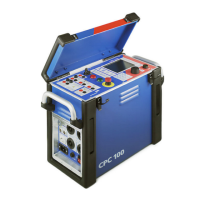CPC 100 in a Network
11 - 3
These two connectors only differ in one cross-connection in the upper RJ-45
connector "PC".
For both RJ-45 sockets the same 10BaseT connection cable type can be used.
Therefore, make sure to insert your 10BaseT connection cable into the correct
CPC 100 socket.
The communication protocol is the TCP/IP protocol.
Setting the Communication Parameters
CPC 100
For two devices to communicate using TCP/IP (the most-commonly used
protocol for Ethernet), both devices need a unique network address, that is, an
address that is different from all other addresses within this network.
In addition, these devices need an identical subnet mask.
The CPC 100 communication parameters are set on the Network tab of the
Options (refer to ”Network” on page 2-37).
DHCP/Auto-IP
Most PC networks have a DHCP (Dynamic Host Configuration Protocol) server
that provides an address for every device connected to the network and defines
the subnet mask. When connected to such a network, setting CPC 100 to
DHCP/Auto-IP mode enables it to obtain an address from the DHCP server. If
there is no DHCP server (for example, because CPC 100 is directly connected
to a PC), CPC 100 generates its address automatically (Auto-IP).
Older versions of Microsoft Windows, such as Windows 95 or NT 4.0, support
DHCP but not Auto-IP. For details about how to establish a communication via
a direct connection, refer to the section ”Setup for Windows 2000, Vista, XP” on
page 8 of this chapter.
Static IP
In smaller PC networks, all computers have individual static IP addresses. The
system administrator has to assure that no IP address is used twice. He
provides you with a unique address and all other settings for CPC 100.
If, by mistake, an IP address is used twice in the network, communication of
one or both of the devices will fail to work.
If you are in doubt, set PC and CPC 100 to DHCP/Auto-IP.
Note: Connect only one RJ-45 connector at a time.

